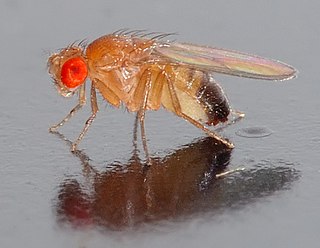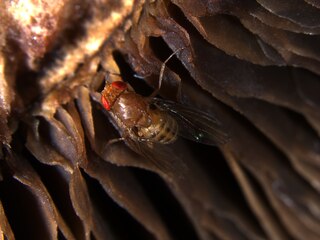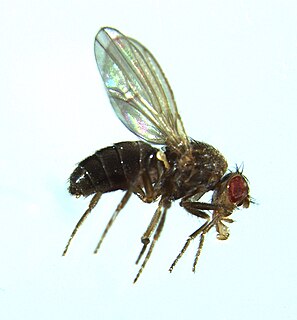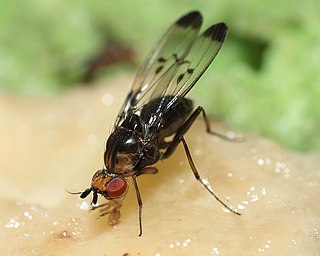Related Research Articles

Drosophila is a genus of flies, belonging to the family Drosophilidae, whose members are often called "small fruit flies" or pomace flies, vinegar flies, or wine flies, a reference to the characteristic of many species to linger around overripe or rotting fruit. They should not be confused with the Tephritidae, a related family, which are also called fruit flies ; tephritids feed primarily on unripe or ripe fruit, with many species being regarded as destructive agricultural pests, especially the Mediterranean fruit fly.

Allopatric speciation, also referred to as geographic speciation, vicariant speciation, or its earlier name, the dumbbell model, is a mode of speciation that occurs when biological populations become geographically isolated from each other to an extent that prevents or interferes with gene flow.

The Caenophidia are a derived clade of alethinophidian snakes, which contains over 80% of all the extant species of snakes. The largest family is Colubridae, but it also includes at least seven other families, at least four of which were once classified as "Colubridae" before molecular phylogenetics helped us understand their relationships. It has been found to be monophyletic.

Drosophila simulans is a species of fly closely related to D. melanogaster, belonging to the same melanogaster species subgroup. Its closest relatives are D. mauritiana and D. sechellia.

The Drosophilinae are the largest subfamily in the Drosophilidae. The other subfamily is the Steganinae.
The Drosophila melanogaster species subgroup contains 9 species of flies, including the best known species Drosophila melanogaster and D. simulans. The subgroup belongs to the Drosophila melanogaster species group within the subgenus Sophophora.
The Drosophila melanogaster species group belongs to the subgenus Sophophora and contains 10 subgroups. The phylogeny in this species group is poorly known despite many studies covering many of the species subgroups. The most likely explanation is that the various subgroups diverged from each other in a relatively short evolutionary time frame. Three subgroups have not yet been investigated in molecular studies, and their position in the phylogeny is unclear. The suzukii subgroup is paraphyletic as D. lucipennis is systematically placed within the elegans subgroup.

The paraphyletic subgenus Sophophora of the genus Drosophila was first described by Alfred Sturtevant in 1939. It contains the best-known drosophilid species, Drosophila melanogaster. Sophophora translates as carrier (phora) of wisdom (sophos). The subgenus is paraphyletic because the genus Lordiphosa and the species Hirtodrosophila duncani are also placed within this subgenus.
In phylogenetics, basal is the direction of the base of a rooted phylogenetic tree or cladogram. The term may be more strictly applied only to nodes adjacent to the root, or more loosely applied to nodes regarded as being close to the root. Each node in the tree corresponds to a clade; i.e., clade C may be described as basal within a larger clade D if its root is directly linked to the root of D. The terms deep-branching or early-branching are similar in meaning.

The immigrans-tripunctata radiation is a speciose lineage of Drosophila flies, including over 300 species. The immigrans-tripunctata radiation is a sister lineage to most other members of the subgenus Drosophila. A number of species have had their genomes or transcriptomes sequenced for evolutionary studies using Drosophila.

Drosophila is a paraphyletic subgenus of the genus Drosophila, a classification of fruit flies. This subgenus was first described by Alfred Sturtevant in 1939. Members of the subgenus Drosophila can be distinguished from other Drosophilid species by breaks in the pigmentation along the dorsal section of their abdomen.

The genus Zaprionus belongs to the family fruit fly Drosophilidae and is positioned within the paraphyletic genus Drosophila. All species are easily recognized by the white longitudinal stripes across the head and thorax. The genus is subdivided in two subgenera, based on the presence of an even or odd number of white stripes. The species of the genus can be found in African and Southern Asia. One species, Zaprionus indianus, has invaded the New World.

Drosophila willistoni is a species of fruit fly. It was originally described by Alfred Sturtevant in 1916. It ranges from Florida, Mexico and Caribbean islands southwards to Argentina and is the most common Drosophilid fruit fly in the Amazon rainforest.

Drosophila virilis is a species of fruit fly with a worldwide distribution, and was one of 12 fruit fly genomes sequenced for a large comparative study. The males have bright red gonads that can be seen through the cuticle.
Sigmavirus is a genus of viruses in the family Rhabdoviridae, order Mononegavirales. Sigmaviruses naturally infect dipterans.

Drosophila subobscura is a species of fruit fly in the family Drosophilidae. Originally found around the Mediterranean, it has spread to most of Europe and the Near East. It has been introduced into the west coasts of Canada, the United States, and Chile. Its closest relative is Drosophila madeirensis, found in the Madeira Islands, followed by D. guanche, found in the Canary Islands. These three species form the D. subobscura species subgroup. When they mate, males and females perform an elaborate courtship dance, in which the female can either turn away to end the mating ritual, or stick out her proboscis in response to the male's, allowing copulation to proceed. D. subobscura has been regarded as a model organism for its use in evolutionary-biological studies.

Afrophidia is a clade of alethinophidian snakes comprising the groups Henophidia and Caenophidia, essentially making up the snakes people commonly associate with. The name refers to the deep split between Afrophidia and their sister taxon, Amerophidia, which originated in South American origin, and the afrophidians was recently hypothesized to represent a vicariant event of the breakup of Gondwanan South America and Africa.

The Drosophila immigrans species group is a polyphyletic and speciose lineage of Drosophila flies, including over 100 species. Immigrans species belong to the Immigrans-tripunctata radiation of the subgenus Drosophila. Well-described species include Drosophila immigrans, and the sister species Drosophila albomicans and Drosophila nasuta. The genome of D. albomicans was sequenced in 2012 in an effort to characterize novel sex chromosome development in D. albomicans. Immigrans group species are related to mushroom-breeding Drosophila of the Quinaria and Testacea species groups.

Drosophila silvestris is a large species of fly in the family Drosophilidae that are primarily black with yellow spots. As a rare species of fruit fly endemic to Hawaii, the fly often experiences reproductive isolation. Despite barriers in nature, D. silvestris is able to breed with D. heteroneura to create hybrid flies in the laboratory.

The Hawaiian Drosophila are a paraphyletic and speciose lineage of Drosophila vinegar flies, and members of the subgenus Drosophila. Over 1000 species of Drosophila are endemic to the Hawaiian islands. The Hawaiian Drosophila species also include the "picture-wing" clade of Drosophila, named for the intricate patterns of melanin pigment on their wings. Over 100 species belong to the picture-wing clade of flies, prompting the generation of a database devoted solely to wing diversity in the Hawaiian Drosophila lineage. The Hawaiian Drosophila species group is paraphyletic, as the Scaptomyza genus is nested within the Hawaiian Drosophila clade.
References
- ↑ O'Grady, Patrick M.; Clark, Jonathan B.; Kidwell, Margaret G. (1998). "Phylogeny of the Drosophila saltans Species Group Based on Combined Analysis of Nuclear and Mitochondrial DNA Sequences" (PDF). Molecular Biology and Evolution. 15 (6): 656–664. doi: 10.1093/oxfordjournals.molbev.a025969 . PMID 9615447.
- ↑ Rodríguez-Trelles, F.; Tarrío, R.; Ayala, F. J. (1999). "Molecular evolution and phylogeny of the Drosophila saltans species group inferred from the Xdh gene" (PDF). Molecular Phylogenetics and Evolution. 13 (1): 110–121. doi:10.1006/mpev.1999.0631. PMID 10508544.
- 1 2 Markow, Therese A.; O'Grady, Patrick (2005). Drosophila: A Guide to Species Identification and Use. Academic Press. pp. 43–56. ISBN 978-0-08-045409-2.